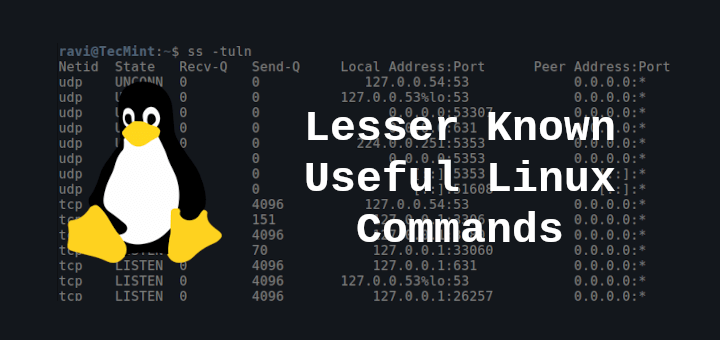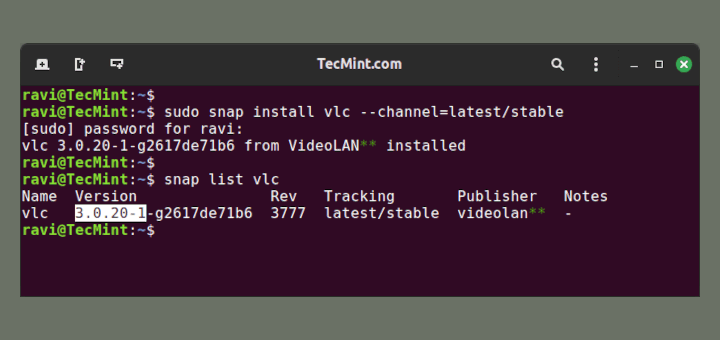In this article, we are going to review and see how we can schedule and run Linux tasks in the background automatically at regular intervals using the Crontab command.
Dealing with a frequent job manually is a daunting task for system administrators and such tasks can be scheduled and run automatically in the background without human intervention using cron daemon in Linux or Unix-like operating system.
For instance, you can automate Linux system backup, schedule updates, and synchronization of files, and many more using Cron daemon, which is used to run scheduled tasks from the command line or use online tools to generate cron jobs.
Cron wakes up every minute and checks scheduled tasks in countable – Crontab (CRON TABle) is a table where we can schedule such kinds of repeated tasks.
Tips: Each user can have their own crontab to create, modify and delete tasks. By default cron is enabled for users, however, we can restrict users by adding an entry in /etc/cron.deny file.
Crontab in Linux
The Crontab file consists of commands per line and has six fields actually and separated either by space or tab. The beginning five fields represent the time to run tasks and the last field is for command.
- Minute (hold values between 0-59)
- Hour (hold values between 0-23)
- Day of Month (hold values between 1-31)
- The month of the year (hold values between 1-12 or Jan-Dec, you can use the first three letters of each month’s name i.e Jan or Jun.)
- Day of week (hold values between 0-6 or Sun-Sat, Here also you can use the first three letters of each day’s name i.e Sun or Wed. )
- Command – The /path/to/command or script you want to schedule.
1. List Crontab Entries
List or manage the task with the crontab command with -l option for the current user.
# crontab -l 00 10 * * * /bin/ls >/ls.txt
2. Edit Crontab Entries
To edit the crontab entry, use -e the option shown below. The below example will open scheduled jobs in the VI editor. Make necessary changes and quit pressing :wq keys that save the setting automatically.
# crontab -e
3. List Scheduled Cron Jobs of User
To list scheduled jobs of a particular user called tecmint using the option as -u (User) and -l (List).
# crontab -u tecmint -l no crontab for tecmint
Note: Only root user have complete privileges to see other users’ crontab entries. Normal users can’t view others.
4. Remove Crontab Entry
Caution: Crontab with -r the parameter will remove complete scheduled jobs without confirmation from Crontab. Use -i option before deleting the user’s crontab.
# crontab -r
5. Prompt Before Deleting Crontab
crontab with -i the option will prompt you confirmation from the user before deleting the user’s crontab.
# crontab -i -r crontab: really delete root's crontab?
6. Allowed Special Characters (*, -, /, ?, #)
- Asterisk(*) – Match all values in the field or any possible value.
- Hyphen(-) – To define a range.
- Slash (/) – 1st field /10 meaning every ten minutes or increment of range.
- The Comma (,) – To separate items.
7. System-Wide Cron Schedule
A system administrator can use the predefined cron directory as shown below.
- /etc/cron.d
- /etc/cron.daily
- /etc/cron.hourly
- /etc/cron.monthly
- /etc/cron.weekly
8. Schedule a Job for a Specific Time
The below jobs delete empty files and directories from /tmp at 12:30 am daily. You need to mention the user name to perform the crontab command. In the below example, root user is performing a cron job.
# crontab -e 30 0 * * * root find /tmp -type f -empty -delete
9. Special Strings for Common Schedule
| Strings | Meanings |
|---|---|
| @reboot | The command will run when the system reboots. |
| @daily | Once per day or may use @midnight. |
| @weekly | Once per week. |
| @yearly | Once per year. we can use the @annually keyword also. |
Need to replace five fields of the cron command with keywords if you want to use the same.
10. Multiple Commands with Double ampersand(&&)
In the below example, command1 and command2 run daily.
# crontab -e @daily <command1> && <command2>
11. Disable Email Notifications.
By default, cron sends mail to the user account executing cronjob. If you want to disable it add your cron job similar to the below example. Using the >/dev/null 2>&1 option at the end of the file will redirect all the output of the cron results under /dev/null.
[root@tecmint ~]# crontab -e * * * * * >/dev/null 2>&1
conclusion: Automation of tasks may help us to perform our tasks in better ways, error-free, and efficient. You may refer to a manual page of crontab for more information by typing the ‘man crontab‘ command in your terminal.








It is easy to test that the five crontab timing parameters do what you expect. There is a sandbox at cronbuddy.com, enter your values and get back a schedule of run times.
Hi,
I want to know about the backup process…
How to take OS backup from Linux server and store in AWS storage using crontab cmd from Linux…
Please help us…
Hi,
I want to remove all empty files and directories from /tmp at 12.30 am daily. How can I do it??
Regards,
@Rinsha,
You need to add the following cron job to do.
Why my command doesn’t work ?
(the program onedrive in a normal command works well)
You have not specified an execution time in your crontab statements.
Asterisk
(*)means all values.Hey, Ravi,
Can you provide some examples of the common things that Linux System Administrators automate via Crontab?
I have two jobs set, one to output the first two lines of
df -H, and to output the uptime to a log. Both for historical record-keeping, but I’m struggling to find things that *should* be automated.01 1 1 * * df -H | head -n 2 >> /var/log/df.log 2>&101 3 1 * * uptime >> /var/log/uptime.log 2>&1
I get that it will always be contextually related to the things that need to happen in your environment, and my environment is just that of a person learning Linux administration.
I just learn by example and am drawing a blank.
-Dalton
Hello users here is a very nice website for creating a crontab command within few second with your schedule,
crontabgenerator.org
Please review it and let me know if you have any query.
thanks
Hello users here is a very nice website for creating a crontab command within few second with your schedule,
crontabgenerator.org
Please review it and let me know if you have any query.
thanks
any one can help me to run cronjob for every 45 days
@Prakash,
This is not right. This can only accept values from 0-31, than how can it be 45.
This is completely wrong.
Daniel is right. to run at every 45 days, you need to enter 2 lines.
Nice to read it!
Hi I am not able to install cron in my Centos 7 machine
@Susmita,
Cron comes pre-installed on all Linux distributions, you don’t need to install it..
I need something to call a .php webpage every minute, can this be handled?
@Hans,
Yes, you can call any webpage via cron every minute.
Thanks for this share, I need your help on an real urgent basis, I need my server to automatically update its dynamic ip with the DDNS provider every time my system reboots or boots, kindly help me with the command, i am using ddclient for dynamic ip updating to my DDNS provider with the following command:
kindly tell me the exact command for running the above command as root as soon as my system boots up.
Secondly i want my server to execute this command on every reboot even if no one has logged in yet, is it possible to run the command using crontab before even anyone logs in the server?
Really Appreciate any help from any of you who knows how to do it..
Regards
@Junaid,
Which Linux distribution you’re using? if it’s CentOS, you can add the below command to /etc/rc.local file, this file executes commands when system boots up.
I got one requirement i need your help.
One unix command need to run 3 time
with time intervel of 5 min.
@Sudhir,
With cron that would not possible, but you can use sleep command to achieve the same.
@Sudhir,
Create a following shell script and add the command that you want to execute every 5mins..
I would like to schedule crontab job by shell script
crontab -e
*/10 5 * * 2 /abc/test.sh
Escape
:wq!
I am wondering where to put #!/bin/sh
@Sarah,
No need to put shebang syntax in crontab entry and the added entry work well..
If u want u can add in your script file.[At Beginning of your script].
I am facing problem in crontab .
i create file on desktop in linux centos 6 .
name of file is file .php
in crontab -e : 1 * * * * root echo “hello waqas how r u ” >> /home/waqas/Desktop/file.php
cronjob executed but nothing found in file and file is r-w-x please help me sir
#!/bin/bash
cd /var/www/html/taskScheduling/
rails runner Task.SendData
this is the script, that i ma trying to run using cron tab, but it is not running. directory is changing accordingly but the next one is not…plz reply how to run the command from cron tab ” rails runner Task.SendData”
@Pawan,
First create a file called “rails.sh” and add the content of script, now open the crontab file add the following line:
For example, the above script runs daily at 11:30pm.
hello
my cron job is executing but write noting in the file. I have created a file
file.phpon Linux centos 6 desktop and add a job in crontab -e.job execute but no words shown in the file and file is r-w-x please help me
@Waqas,
you should add the binary location of php to execute PHP files properly via cron as shown:
how to send mail alert to superuser if any user do changes in the scheduled job
@Manju,
Use this following script to track the changes to crontab files and if any changes would take place it will send a mail alert.
thanks.
but my cron job duplication records.
how to avoid duplication
my cron job running every minutes
Hi Ravi,
I Want to run cronjob every Tuesday, as of my knowledge (* * * * 2 command), but here Im having some doubt every week tuesday means we can mention * in day of month field or not. can u help me out.
@hari,
I hope this what you looking for, the following cron will every Tuesday at 11:15am in the morning..
# min hour date month day command
10 11 * * 2 path and command
Hi Ravi, @daily is mentioned twice (repeated) under point no. 9(Special Strings for Common Schedule) . Good tut.
@Tanmaya,
Thanks..corrected in the writeup..
I know this was covered once, but && and || don’t mean exactly what is written above. && and || act like If..then logic where && is “then” and || is “else.” So in the cases mentioned in comments and in the article, you won’t get what you expect…. cmd1 && cmd2, will execute cmd1 and if it exits correctly (no errors) then cmd2 will be executed. In the case of cmd1 || cmd2, it’s the opposite, if cmd1 exits with something OTHER than exit 0 (there WERE errors,) then it will execute cmd2. SO! You COULD do something like, cmd1 && || which will work exactly like an if..then…else logic block.
If you DO want to run multiple commands, you can do it two ways. Way the first, you could write a script and then have cron execute that script. I find that to be the best way cause then I get to add all sorts of logic and error handling that can’t be done on a single line in cron. If you don’t need to be fancy, the other way to go about it is:
@daily /path/to/cmd1 ; /path/to/cmd2 ; /path/to/cmd3; etc….
Keep in mind that this is true on the command line itself as well. You can:
$ cmd1 ; cmd2
OR
$ cmd1 && cmd2 || cmd3
Thanks for the article. a useful tool crontab syntax generator like http://www.crontab-generator.org/ can help you write crontab line correctly.
Hi Ravi,
Thnx for the tutorial, however I am trying to delete the contents of a temp folder every second. I am using the following command:
As I can only delete files in this folder als root, I do the following.
$ sudo crontab -e
*/1 * * * * find /tmp -type f -empty -delete >/dev/null 2>&1
When I check with:
ps -ef | grep cron
It shows only for the current user that cron has run, but not for root.
Could you tell me what I am overlooking?
Cheers!
@Haiyun,
You must have root privileges to do that..Please add the cron entry as root user…
One thing worth mentioning is that since cron runs in the background, its important to make sure you have some sort of logging or monitoring in place to make sure things are working as intended. Its all too easy to take things like this for granted, only to realize too late that something has been failing or perhaps not even running at all. https://www.cronalarm.com is a great service to help you keep tabs on all your cron jobs and scheduled tasks.
Cron jobs meant for particular user fails to start automatically whenever the server undergoes reboot. what is the solution, to enable the cronjobs of that user to start automatically after the reboot?? help me…..
Thanks in advance… :)
cant get this to run using command sudo crontab -e
and i added this
*/5 * * * * php -f /var/www/html/cj/email1.php >/dev/null 2>&1
but it only works when i goto page manually any ideas please anyone?
@Jay
use this way..
hello and good day
I write script file that include tar command. when I write ./name file, then it works. but when write below command in crontab, it doesn’t work
1 * * * * /home/dira/filename
do you know why does it work?
best regards
@Hasani,
The cron entry you’ve added was wrong, please user correct cron entry as shown.
There is a good crontab GUI for finding out about the scheduling commands at http://www.cronsandbox.com
11. Disable Email Notification can also be done with MAILTO=””
Thanks for your great tutorial :)
Really helped me.
Akee, thats one way. Another way to have both commands run no matter what is to use “||” instead of “&&”
@daily ( command1 || command2 )
hth
This line : “@daily && ” does not mean that command1 AND command2 will be run on a daily basis. It means that command1 will be run on a daily bases, and IF the return code of this command is 0 e.g a success, THEN command2 will be run after.
You need to have two lines if you want both command to be run in any case :
@daily
@daily